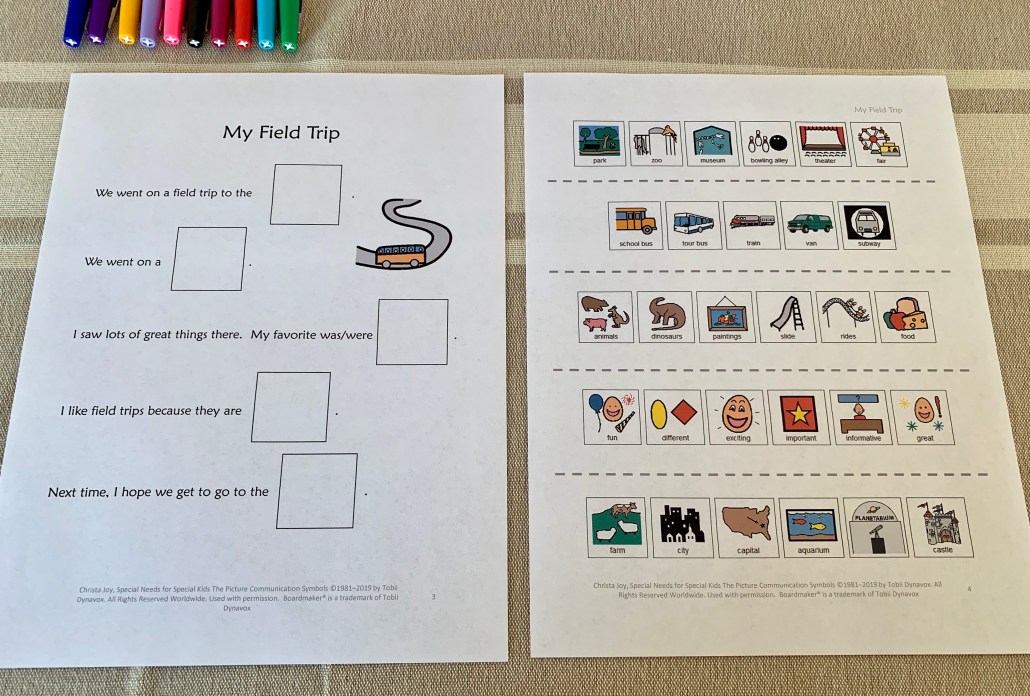Taking a field trip is never easy. But, if you teach in a special education classroom, then it can be especially challenging. Here are some ways to make sure you not only have a great field trip, but a safe one as well. Plus, I have some free downloads included to help you out.
Before the trip
There are some things you can do before the trip to make the day less stressful for you, the students, and chaperones.
1. Get as much background information as you can about your destination.
So this is the step that many regular education teachers do not have to worry about so much. If you teach students with significant needs, this is the step the will make all the difference. The more you can familiarize yourself and your students with the location, the better your chances for a smooth and pleasant experience. Here are some things to consider:
- Do you need to know if it is handicap accessible ?
- What is the general layout?
- Are there places to take a break or de-stress if needed?
- Do the people who work there know you are coming, and what the general make-up of your class is like? (This can be very helpful if you have students with behaviors that may seem disruptive or even rude if people are not aware they have a disability).
- Is there are shelter from the sun or rain?
- Are snacks and drinks allowed?
The most successful trip I ever took was also the one I took with my most challenging student. I actually went to the park ahead of time and took lots of pictures. We used those photos to familiarize all the students with the location. In addition, they helped the other adults see where the potential issues and triggers could be. It allowed the entire team to come up with a really good plan. Finally, it lessened this one student’s anxiety about visiting an unfamiliar location.
2. Review the rules and expectations with your students.
As always, being very clear in your expectations when it comes to behavior is critical. I would be reviewing these daily for about a week ahead of time. Remember repetition, with some variety, is key for students to begin making those rules part of their own internal dialog. I have a few social stories you may find helpful with this review. Just click on the titles below to check them out.
3. Create and review a detailed schedule of events.
Using whatever learning level is most appropriate for your students, create a schedule of how the day will run. It may be a picture schedule, a simple checklist, or even an object schedule. It is great if you can make multiple copies so that each student has their own. In addition, each chaperone should have a copy as well. I would laminate these or put them in a page protector to minimize wear and tear.
Day of the Trip
1. Make sure your chaperones are prepared physically and mentally.
This cannot be over-emphasized: you need to make sure everyone is on the same page. Keeping in mind confidentiality issues, you want to make sure any adults that are coming are also prepared for any issues that may arise. This includes:
- Things that could trigger problem behaviors, like loud sounds, crowds, animals, bright lights, crying children, etc.
- Behavior plans that are currently in place. Specifically the de-escalation procedures for students who may be in their group.
- Method of preferred communication for each student in their group including how to use any devices.
- Any allergies or food restrictions.
2. Gather all your materials.
I have come up with a free checklist you can download to help get organized. Of course there will be some student specific needs you will have to consider, but this is a place to start. Just click the HERE to download it. (no email needed)
3. Have an emergency back-up plan.
We all know the best-laid plans can be undone in a heartbeat. I always had a backup plan in case things just went totally off the rails. If fact, I often had 2 plans. Plan 1 was in case just a few (or one) students were not able to hang with the rest of the group. I wanted a way for the rest of the class to continue on with the trip and get the full experience. Plan 2 was in case something happened which derailed the entire trip in general. Many of our students have so much trouble with change. Having to cancel a trip for something out of my control is always a possibility, so I tried to have some back-up “safe” location. This was never the preferred option, as many of the students were expecting to go to location A, but at least going to location B was better than not going anywhere at all. I usually had a local park or local school playground set up as a back-up. That way I didn’t have to do a lot of prep. It was a safe, known location to me that I felt we could handle with little upfront work.
4. Review the schedule and expectations.
Before heading out, review the big points one more time. It may be reading the social story as part of your morning meeting. Or, it may mean handing out power cards your students made to take with them as portable reminders. Despite the likely chaos of the morning, make sure to review the expectations one more time.
After the Trip
Whew! You made it and hopefully everyone had the best time. Go home and celebrate and re-energize. But, the next day you want to start thinking of what types of activities you can do to extend and build on that experience. Maybe you want your students to write a story about their trip. I have a FREE writing prompt you can download below. Although I do include pictures for students to use, it may be more beneficial to use some material you have that is more specific. If you took a lot of pictures, put together a slide show. You can even create a simple scavenger hunt students can do AFTER the trip. Have them mark all the things they found the day before. Finally, review those expectations one more time. But, this time make sure you point out who did what well. So if the rule was “I will stay with my group,” be sure to praise all the students who did this really well. Reinforcement is such a powerful tool, make sure to use it.

I hope this post had at least one ah-ha moment for you. Hopefully there was something here that will make your next field trip a little less stressful. Let’s face it, most teachers dread field trips. They are A LOT of work and take A LOT of preparation. But for some of our kids, this may be the only way they are able to get out in their community.


3 Comments
Comments are closed.